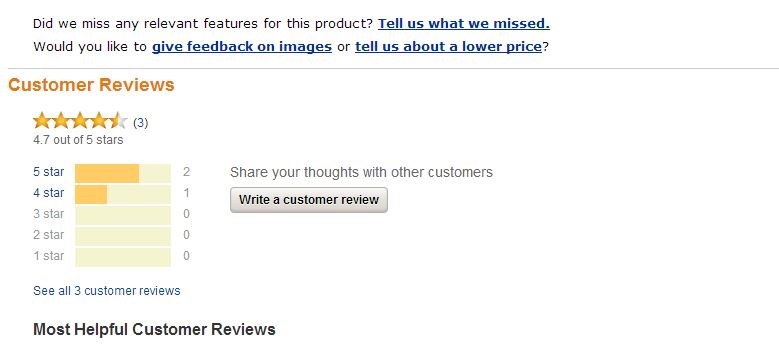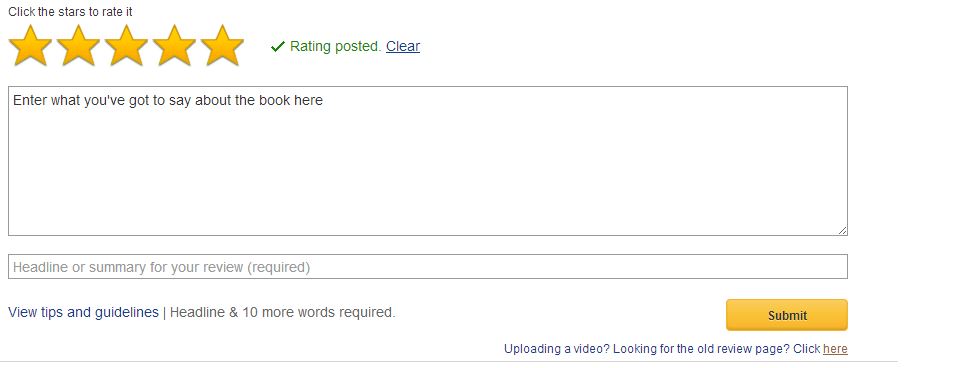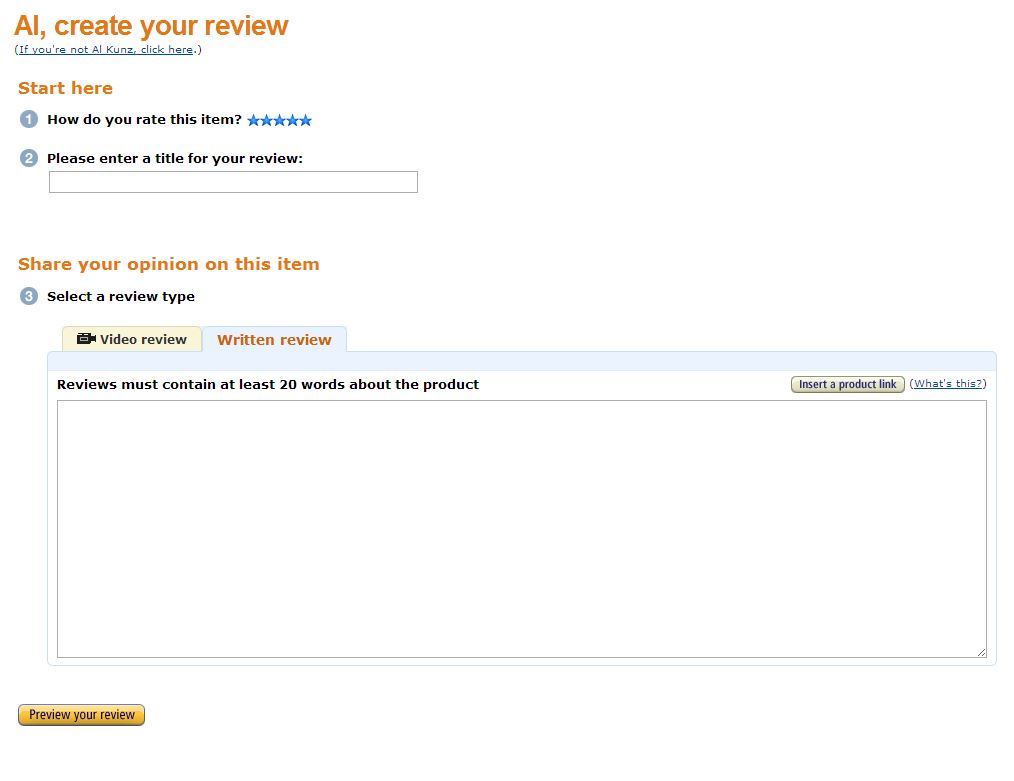 Odds are if you’re a reader who’s visiting Indies Unlimited that you read a lot of books, some (many? all?) of which are written by indie authors. If you’ve communicated with one of those authors, maybe sent them an email or posted a comment on their Facebook page telling them you loved their book, chances are good they’ve hit you up for a review. You don’t even have to make the first move to have this happen. Sometimes you’ll be reading a book, come to “The End,” and before you can page forward to read about the author you’ll find a message something like this:
Odds are if you’re a reader who’s visiting Indies Unlimited that you read a lot of books, some (many? all?) of which are written by indie authors. If you’ve communicated with one of those authors, maybe sent them an email or posted a comment on their Facebook page telling them you loved their book, chances are good they’ve hit you up for a review. You don’t even have to make the first move to have this happen. Sometimes you’ll be reading a book, come to “The End,” and before you can page forward to read about the author you’ll find a message something like this:
Thank you, thank you, thank you for reading my book. Did you like it? You loved it, I know you did. Before you call all your friends to tell them about this GREAT book you just finished (which you should do), first won’t you jump on Amazon and tell the world how much you LOVED, LOVED, LOVED my book by leaving a review? Thanks. I’ll love you forever.
I know, they’re relentless. You’re under no obligation to do so. But, if you’re like me, you root for the underdog (indie authors are, although becoming less and less so) and you might want to help with a review. This series is an attempt to give a little guidance for people who want to do a review on Amazon, but don’t know where to begin, starting with the bare minimum and then expanding on that for those who are interested in going further. If you really don’t want to write a review (yes, Laura, I’m looking at you) I’d suggest telling the author that you’d love to, but have no clue how to write a review or even how to enter it on Amazon. Tell them, “you’re the writer, not me,” in an attempt to appeal to their vanity. If you try this and the author then sends you a link to this post, I’m sorry.
In Part 1 we’re going to cover the easy part, with a brief tutorial on entering your review at Amazon. Part 2 is an attempt to help non-reviewers who have no idea where to start in writing a review. This will be followed by Part 3 with some additional ideas to help those who are interested in moving beyond the bare minimum. Finally we’ll wind up the series in Part 4 with some discussion about a few other considerations and where you might go from there.
Entering a review in Amazon really is easy (writing it, not so much). The only tricky part is that how this is done has a couple variations. First, we’ll talk about the required steps if you do it the default way on Amazon.com.
Start by going to the page for the book on Amazon. (This works for other items too, but we mostly care about books around here.) You managed to purchase the book, so I’m assuming you know how to do this. If you’ve never made a purchase at Amazon, you’re off the hook because Amazon requires a customer account be setup and have at least one item purchased before they’ll allow a person to post customer reviews. (You aren’t required to have purchased the item you’re reviewing from Amazon, although there is an indication on the review if you did.)
Look down the page and you’ll see a section that looks like this.

Click on the button that says “Write a Customer Review.” Sometimes it will be where it is shown in this screen shot. Other times you’ll need to scroll down the page where you’ll find it at the bottom of some of the other customer reviews. After clicking you’ll be taken to a page that will have a blank form with some identifying characteristics of the book you’re going to review. (Below, you’ll probably see a bunch more sections like this for other purchases that you haven’t reviewed which is Amazon’s way of encouraging you to review everything. They’re easier to ignore than a needy author, so I ignore those.)

Start entering your review by clicking the number of stars you want to give the book (clicking the leftmost of the five stars for a one star review, the rightmost for a five star). Then enter whatever you want to say in your review in the box below the stars where it says “write your review here.” I usually write my review in a word processor and copy/paste it into this box, but there is no reason why you can’t draft yours as you enter it here. Once you’ve started entering your review another box will be displayed below it for the “headline or summary” of your review.

Now enter a “headline or summary” in the box as indicated. We’ll talk about what you might put there when we discuss writing the actual review in Part 2.
In some situations you might also have a couple check boxes that are shown at some point. One of them will be pre-checked and only show if you purchased the item from Amazon. Leave it checked. There is sometimes a box to click indicating that you are at least 13 years old. If you are, click it (you won’t be allowed to submit the review without doing so). If you aren’t or can claim not to be, this is a way of getting out of doing this. Or I guess you kids could lie. Just don’t tell your parents I said it was all right.
The screens shown and the steps described above are relatively new and so far are only what you’ll find on Amazon.com although there is a good chance these changes will eventually be migrated to the other Amazon sites. Personally, I prefer the old way. If you think you might, too, or you’re entering a review on an Amazon site that doesn’t look like those shown above, we’ll talk about that next. Otherwise, click the big yellow submit button to the bottom right of the headline box and you’re set. If you’ve neglected to fill in the headline box, click the stars, or enter a review of at least 20 words, you’ll receive an error message and need to fix the problem. If you’re taken to another page, you’re done.
For other sites, you’ll see a screen that looks like the one below. If you’re on Amazon.com and would prefer to go old school, click the link in the message below the submit button to get this same screen.

The elements of the review are the same as in the other screens. Click a star, enter the headline or summary (called Title here) and enter the verbiage of your review in the big box at the bottom. You might also see the check boxes mentioned above. If so, handle them the same way.
Once the review is entered, click on the ‘Preview your review’ button. Your review will be checked for the same things mentioned above for the submit button on the new form. If it doesn’t pass you’ll be told what is missing (fix it and click the button again). If it does pass, you’ll be taken to another page that shows a preview of what your review will look like. Scan it to make sure all looks good and click the yellow “Publish review” button. You’ll be taken to another page and you’re done. If you see something you’d like to change, click the ‘Edit’ button and you’ll be taken back to the previous page to fix the problem and try again.
That’s it. Simple, right? The hard part is knowing what to enter in those boxes which I’ll try to help with in Part 2, coming January 24, 2014.

🙂 Keeping this link hot and forwarding to all those who say “I’d love to, it was such a great read, but I never wrote a review on Amazon…”
Thanks for the comment, Massimo. Part 2, coming 2 weeks from today, will be an attempt to help them figure out what to say for those intimidated by the idea.
🙂
Excellent. Keeping it simple will take some of the fear out and nudge readers to write a review. I do think many readers have no idea how important their opinions, stated publicly, are.
Thanks, Yvonne. I’m trying not to say too much (don’t want to steal my own thunder), but 25 words, Amazon’s minimum word count for a review, isn’t that tough.
I will be bookmarking this series for future reference. 🙂 Thanks, Al!
Thanks for the comment, Lynne.
Good one, Al, Excellent idea!
Thanks, TD. I owe the original idea to the lovely Ms Brooks. But it experienced a little scope creep from the original thoughts. (I think that’s a good thing in this case.)
Thanks for the post, great information.
Thanks for reading it, Frank.
Excellent Post, Al. I read many books last year and there was only one that was not written by an Indie. I root for the underdog as well and will give a good review on Amazon if the book is well-written. I also do beta reading for Indies – if anyone is interested, contact me offline.
Thanks for the comment, S.A. I’d guess 95% of the books I read last year (somewhere between 150 and 200) were indies. Some of the trad pubbed authors who I’d buy their new book as soon as it came out now have 2 or 3 books I haven’t even bothered with yet.
I have written 82 reviews for Amazon, many of them for indie books. I find that, for an aspiring writer, writing reviews is an excellent exercise because you have to say a lot in a few words. Your writing becomes more efficient. I always write out everything I want to say on a word document first. I then capture it with the control-c keys, and when I get to the space on Amazon where the review goes, I transfer it with the control-v function-that way I don’t have to write the whole thing over again. If you have a website and do blogging, a book review also makes a good blog. Sometimes I expand my review for my blog because you can put a lot more material in a blog than you can in an Amazon review.
Thanks for the comment, Robin. I like to claim I’m not a writer, but if I added all the words I’ve written over the years for a few web sites and a magazine I contributed to, I’m somewhere near the end of my fourth novel. Early on, when I was reviewing music in a genre that tends to emphasize lyrics and for a site where the reviewers paid a lot of attention to the words I acquired an appreciation for those who can say a lot with few words. Unfortunately, I think I have a lot of improvement to make in that area. 🙂
As an indie author, I’d just like to say I’ve never begged someone for a review, nor harassed them until they caved in. Subtle hints, yes. Sly offers to stand as a guinea pig to see the impact reviews from sites like, oh, I don’t know – Big Al’s Books & Pals, has on sales, perhaps. But begging? Never… Or at least, not yet.
You’re wearing me down, Julie. 🙂
Thanks for the comment. And the non-begging. 😉
So, to get a review from you, all we have to do is beg??? Dang! I hope I can catch the post before they send that giant fruit basket. I got that idea from Ralphie, you know. 😛
LOL, Nicole. 🙂
No begging, Nickie! Subtle and sly wins the race…
As an indie author, I’ve been fortunate enough to receive positive reader responses to my work. I do ask them, at that time, to post a considered review. In the future I will send this link to your article as well. Thank you for the article.
Thanks for the comment Geoffrey. Hopefully they won’t throw any of my suggested excuses back at you. 🙂
Awesome post, Al. I will point others this direction whenever I hear, “But I don’t know how…”
I read David Gaughran’s excellent book, Let’s Get Visible and went ahead and put in the paragraph suggesting a review at the back of all my books. My reviews pretty much ground to a halt since then, so I’m currently going through and changing the back matter to just, “Thank you for taking the time to read this book,” which is how I really feel. It didn’t seem quite right to ask at the end. I realize asking/suggesting works for some, but apparently the folks who read my stuff don’t appreciate it, so I’m erring on the side of caution. Readers rule, at least in my world.
DV, I read David’s book too. He has a lot of good ideas, but what works for some doesn’t always work for all. I think it depends a lot on your readers and possibly working. Even then, I suspect that it only increases your percentage of readers who review from 1 in a gazillion to one in a half-a-gazillion (or whatever the numbers are). The vast majority of readers aren’t going to do a review and the reality is they don’t have to and shouldn’t feel obligated to. I think anything that encourages them without too much pressure has to help. Hopefully the first part of this series will help, too.
DV: I read David’s book, too: At the back of my books I added: Thank you for taking the time to read (book name). If you enjoyed it please tell your friends or write a short review. Word of mouth is an author’s best friend. In 45 days that gentle plea has thus far toted up above 140 reviews. But! I sent my books over to Big Al Books and Pals first. I figured if the titles pulled a decent review from the master review site, it was safe to promote the books. As both Martin Crosbie and David point out, though, reviews don’t sell books. Reviews work to allow authors to get their titles on top promo sites. I doesn’t matter how many reviews my books have–if I don’t promote them to the reading market, they just linger in cyberspace. I get asked every day to review books. But, there’s a tiny kink in my psyche. I have spent umpteen dollars out of my miniscule budget to have my titles professionally edited, formatted and covered. So when I open another author’s book and I see all that author has invested in is a cover and Scrivener and it is not well composed and full of formatting glitches, I get annoyed. I wish I didn’t, but I do. I’m late to the digital market and incredibly tech challenged. The learning curve is tremendous. Two days ago I was approached by an indie author. He wrote a thriller. I adore thrillers. I said, let me go look at it on Amazon. I did. The dang book is four pages long, selling for 99 cents. Lord have mercy. I felt like pulling out my snake gun. When I come across an indie book I like, I blog it, it tweet it, tell my fans and often write an editorial. But I ain’t trading reviews. If an author need reviews, I’ll introduce you reviewers. I’m happy to do that. End.
I’m blushing, Jackie. Thanks for the comment and good words.
Like I said when the Kirkus-lady came to IU, I’d rather have a Big Al book review over Kirkus any day. Thanks so much for the tutorial! I, too, am bookmarking this for those who say they are a bit confused on how to leave a review. Brilliant!
I can’t wait for the next installment about what to include in a review. I want to write a review for the books I have read (mainly by Indie authors) but I am at a loss about what to include in a review.
I have written reviews on Amazon but I sometimes wonder if they do the authors justice as I tend to ramble though I am always honest about how much I enjoyed them.
I also worry about spoilers so end up hardly giving any description of the book at all. I can’t wait for your next post on this subject and I hope my author friends will be patient with me a bit longer until I have read it! 🙂
AVCarden, Thanks for the comment.I tend to ramble, too. Spoilers are an interesting subject. I mention them late in the series, but don’t think I go into much detail about figuring out whether something is a spoiler. I generally try not to give too much of a description of the action in specific terms unless I have to in order to make a point in the review. Even then, if it might be a spoiler I’ll be as vague as I can. One rule of thumb I use if I’m not sure whether something would be considered a spoiler is whether or not it is mentioned in the description. I figure if the author mentions it there, it can’t be a spoiler. It’s surprising how often something I wonder about is in the description.
Great post and excellent idea for a series, Big Al. I love that get-out: “You’re the writer, not me”. I must use that more often! 😉
I’m afraid I could use it on you, but you can’t use that idea, Chris. 🙂
Thanks for the comment.
Very good idea! Thanks for doing this Al.
Thanks for reading it, Martin. 🙂
Hi Big Al,
Good to see you here. Great blog coming from “the” expert. It’s a very classy piece but did you have to mention: ” Tell them, “you’re the writer, not me,” in an attempt to appeal to their vanity.” ? I had always hoped there was no excuse… LOL … Happy New Year to you
It’s all about helping the reader, Gisela. 🙂
Thanks for the comment.
Thank you, thank you, thank you, BigAl. 😉
Seriously, thank you for starting this series. I’m also bookmarking it for future use. Not just for those readers who feel a little reluctant to write a review, but also so I can write better reviews.
Oh, no. Laurie. Don’t get your hopes up too much. After all, you’re the writer, not me. 🙂